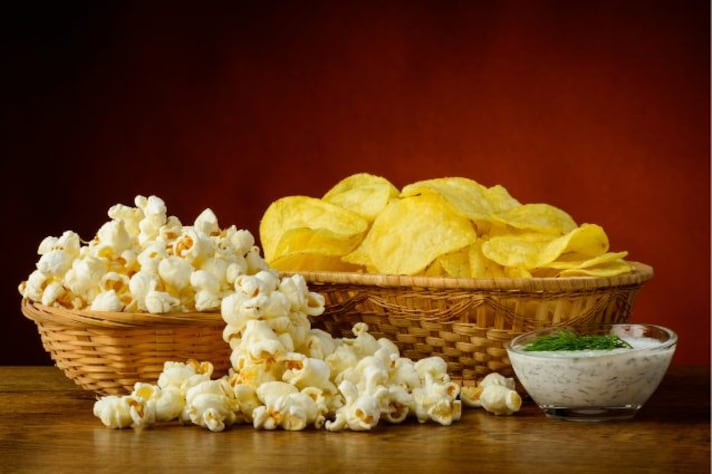A Brief History of American’s Favorite Snacks
The evolution of snacking in America has transitioned from simple indulgences like popcorn and potato chips in the early 1900s to a diverse industry today, reflecting changes in society and dietary preferences. The 1940s-50s saw the rise of convenience snacks, while the 1990s introduced health-conscious options. Currently, the snack landscape offers a vast array of choices, including health-oriented, artisanal, and dietary-specific products. Top snacks range from potato chips to yogurt.

Americans have an undeniable love affair with snacking, a fact that's immediately apparent to anyone stepping into a supermarket across the nation. Aisle after aisle is laden with an assortment of snacks that can easily become the day's highlight, offering a delightful pause between meals. However, the snacking culture that is so integral to American life today has not always existed in its current form. Over the last century, the world of snacking in America has undergone a significant evolution, transforming from a simple, occasional indulgence into a complex industry that mirrors societal changes and technological advancements.
When did Snack Foods Start?
While the act of snacking is as old as humanity itself, the concept of snacking as a recognized part of daily life in America began to take shape in the early 20th century. One of the first snacks to be commercially produced and marketed was the humble popcorn, which gained popularity in the late 1800s, especially at circuses and fairs. However, it was the introduction of potato chips in the early 1900s that truly marked the beginning of the snacking revolution. These crispy, salty slices of potato became an instant favorite, setting the stage for the snack food industry's explosive growth.

Snacking Through the Decades
By the 1940s and 1950s, snacking had become an established American habit, fueled in part by the post-war economic boom and the rise of consumer culture. This era saw the emergence of many snacks that are still beloved today, including various candy bars, chewing gum, and the introduction of frozen treats like ice cream sandwiches. The convenience of these snacks, along with the burgeoning advertising industry, played a pivotal role in their widespread adoption.
The 1990s marked a significant turning point in snacking habits, with a growing awareness of health and nutrition leading to the development of more health-conscious snack options. This period saw the rise of low-fat, low-calorie snacks, granola bars, and the introduction of organic and non-GMO labels, reflecting a shift towards more informed and health-oriented snacking choices.
Today's Snack Landscape
Today, the American snacking industry is characterized by an incredible diversity of options, catering to every taste and dietary requirement. From artisanal and gourmet selections to snacks that cater to vegan, keto, and gluten-free diets, the market has expanded to accommodate the evolving preferences of the American consumer. Snacking is no longer just about indulgence; it's about convenience, health, and even ethical consumption, with a growing emphasis on sustainability and clean eating.

Top 10 Most Famous and Popular Snacks in America
- Potato Chips: The quintessential American snack, beloved for its crispiness and salty flavor.
- Popcorn: A versatile snack that's enjoyed buttered at the movies or as a healthy, air-popped option at home.
- Chocolate Chip Cookies: A classic treat that embodies the comfort of homemade baking.
- Pretzels: With their distinct shape and satisfying crunch, pretzels are a staple snack food.
- Candy Bars: From Snickers to Hershey's, candy bars offer a quick sugar rush.
- Ice Cream: A beloved indulgence available in countless flavors and forms.
- Granola Bars: A convenient and often nutritious option for on-the-go snacking.
- Tortilla Chips: A party favorite, especially when accompanied by salsa or guacamole.
- Trail Mix: A mix of nuts, dried fruits, and sometimes chocolate, offering a balanced snack.
- Yogurt: With its probiotic benefits and variety of flavors, yogurt is a healthy snack choice.
;Resize,width=767;)



